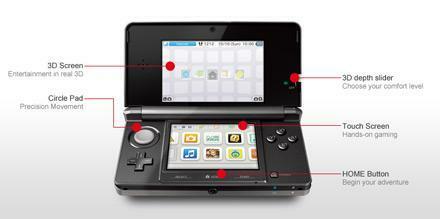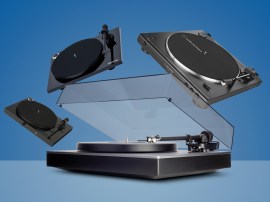IMHO – Is Nintendo’s 3DS worth the money?
It costs more than a Wii, but is that a fair price for 3D technology? Class discuss

The launch of Nintendo’s 3DS has elevated pocket gaming to the third dimension. Now we finally have a launch date (March 25) and a price… well, kind of; Nintendo were pretty reluctant to deliver the only bit of information we’ve been impatiently waiting for, and instead retorted by telling us to “check with individual retailers”. As a price war has already began with prices fluctuating between £220 – £230, it seems like it’ll definitely be worth shopping around.
So there’s no doubt about it, the 3DS is a pricey handheld at almost double the price of the original DS when it first went on sale. Of course Nintendo would say it’s worth every penny, but is it really worth the Moolah?
Before we knew what else Nintendo had on the cards for its autostereoscopic box, the most important feature was glasses-less 3D gaming, which of course eradicates the need for the face furniture – an undoubtedly appealing feature. Other nuggets include three cameras – one on the front, two on the back – a slide pad to scale back the 3D or switch it off completely, an analogue button and backwards compatibility. So far, so interesting.
Post-announcement, we now know Nintendo has more than gaming planned for its 3D handheld and wants it to be used as an entertainment device as much as a gaming console. For example, it has signed deals with Eurosport, Sky 3D and Aardman Animations to deliver content to 3DS devices via Wi-Fi hotspots. There’s also its social side – Street Pass and Spot Pass. The former is all about console communication via Wi-Fi. The DS family have always been pretty social, only now, the 3DS can detect other 3DS consoles – even when in sleep mode – to exchange content. Other features include trading Mii’s, an option to find out who’s playing/downloaded what, as well as who’s online, challenge friends to games and a Channel Live mode that lets your console tune into a friends game and watch them battle it out in Street Fighter IV 3D Edition, for example.
Spot pass offers more of a more conventional Wi-Fi set up, quite similar to Wii Connect24. So whenever you’re in a Wi-Fi hotspot, your 3DS will automatically download any free content available, updates, messages and potentially game demos.
So we’re beginning to see a bit more justification for that price tag, but what else? Nintendo have also opted for single Friend Codes, which means instead of having to input different codes for a number of games, like on the Wii and DS, you now only need one code to engage in some multiplayer action. Then there’s Mii Maker, bringing that popular Wii feature to the 3DS for forming the basis of your Mii character using its cameras. An activity log is on hand if you must know how many hours you’ve spent playing Resident Evil: the Mercenaries 3D Edition, as well as a 3DS e-Shop for downloadable digital content and access to original Game boy and Game boy Advance titles, including the original and very awesome Super Mario Land. Lastly, there’s the preinstalled content – AR (Augmented Realty) and Face Raider. The potential for AR is huge, using dedicated AR cards to interact with the camera; but not being able to go beyond shooting a creature in a box and various other things got boring very quickly. Face Raider makes use of your Mii, so you can essentially put your face in the game and shoot at it – perhaps if you’re feeling particularly hateful about yourself or something. As stand alone games they’re nothing special, but in addition to all the other features you can begin to feel like you’re getting your money’s worth.
With much more than gaming on offer, the 3DS’ appeal certainly goes up a few notches. But what about the games? While there’s no doubt the depth on some games is phenomenal, displaying sharp and prominent graphics, unfortunately, this isn’t consistent across all titles. I didn’t play every game, but based on the titles I managed to get my hands on, the best of the bunch had to be Street Fighter IV 3D Edition, Kid Icarus: Uprising, Pro Evolution Soccer and Metal Gear Solid Snake Eater, which in my opinion all delivered that jaw-dropping and magical 3D we expected. Contrary to that, titles like The Legend of Zelda: Ocarina of Time, Asphalt 3D and Super Monkey Ball 3D didn’t exactly impress when it came to 3D graphic capabilities. Zelda, for example, displayed a disappointing amount of ghosting when the device tiled ever so slightly and like the aforementioned games, if you deviate from that central field of view, you will experience blurring and the inability to focus. This was most obvious with Super Monkey Ball 3D. Even Nintendo were telling us to switch off the 3D completely because the graphics just couldn’t keep up with the movement and induced a drunk-like state in everyone that played it. Of course, the depth slider is on hand to tweak 3D levels, but you shouldn’t feel like you have to use it continually in order to enjoy a game.
Then there are games like steel Diver, which requires 360-degree movement to play to its full potential. In a manufactured Nintendo set up, complete with swivelling chairs, the game is brilliant; in the real world, or at least outside, not so much. This seems like a potential problem for any game that relies quite heavily on the built-in gyroscope and motion sensor. But if you don’t mind looking like a nutcase, this isn’t going to be an issue. Then there are other titles that aren’t particular riveting, but bring something new to the table, like Nintedogs + Cats, which now has face recognition. So as it would appear not all games are created equal, but given that we weren’t looking at fully-fledged products, there’s still time for manufacturers to put in some last minute tweaks so all the games can reach their full potential and deliver full customer satisfaction. Here’s hoping. That said, the games that actually managed to impress made such an impression, the 3DS still feels like an incredible console.
So the question remains – is the Nintendo 3DS worth the money? Compared to other gaming consoles, hells yes. It deviates from the traditional handheld gaming we’re used to, and it doubles up as an entertainment device thanks to the free downloadable content and variety of other features. Its appeal will only increase over time when you think of the potential of the kind of content the 3DS could host – like films.
If you’re going to make use of all the added functionality, the 3DS is absoposilutely worth the cash. However, if you’re sole concern is the 3D games and nothing else, perhaps it’s worth waiting for the price to go down (if you’re patient enough), especially as the technology isn’t as polished as we were expecting (but like I mentioned there’s still time for tweaks). But the fact it offers something no other pocket gamer can right now, works massively in its favour. And one thing is certain – the roster of games on offer is pretty impressive and with more than 30 titles available upon launch, we’re spoilt for choice.
Make no mistake, the 3DS is a massive breakthrough and incredible achievement for gaming, not to mention glasses-less 3D, especially at a time when mobile gaming is going through a tumultuous and competitive time, with the market making a dynamic shift, mainly down to growth of the Android and iDevices. Nintendo has really stepped up its game, though and it’s their best bit of hardware yet. But will people be able to (or want to) afford it? Probably not. But are people going to buy this impressive box of tricks? Probably. And I’m one of them. Put it this way, my DSi is now horribly inferior. I can’t even look at it right now.
What do you think? Is £230 too much to pay for Nintendo’s 3D gamer, or like me, do you think it’s well justified?



